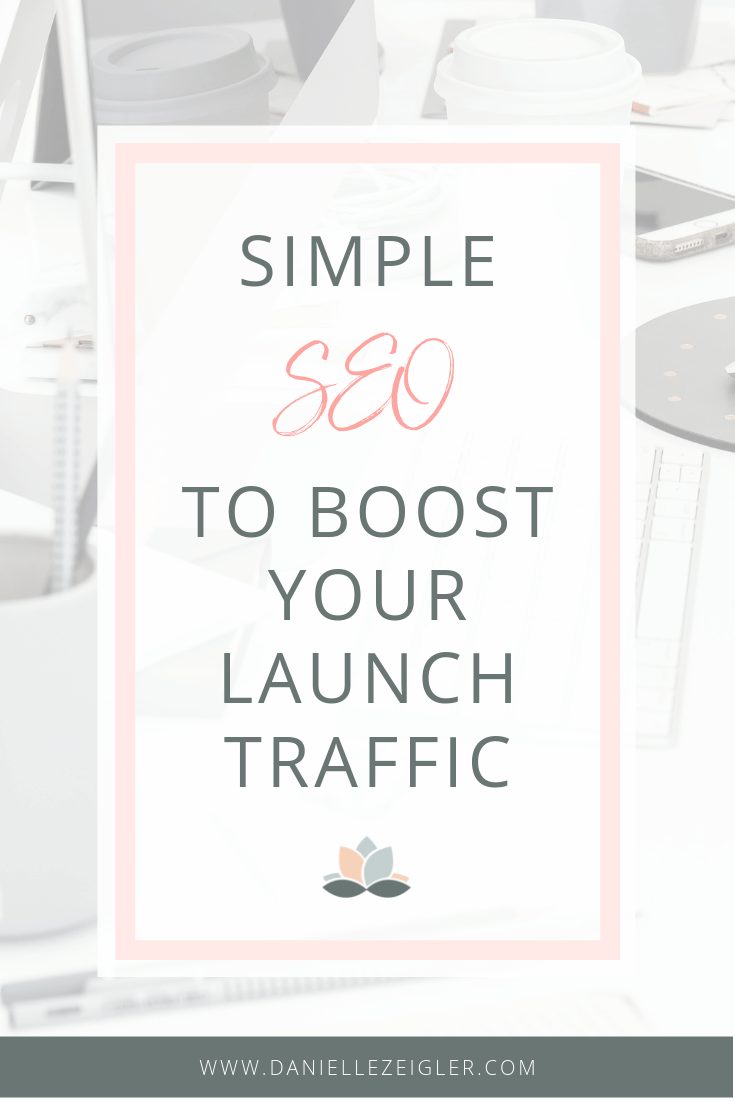Simple SEO to Boost Your Launch Traffic
/Picture this: you’re gearing up to launch your amazing creation online - a book, digital course, mastermind, in-person event, series, experience, bundle, new/relaunched product or service. You and your team have been working hard on all the nuts ‘n’ bolts, the content, the marketing, the graphics, the product/service/event itself, and everything needed to make it a relatively seamless + brilliant experience.
As you’re flying along that particular roller coaster, it’s so easy to forget an essential part of your marketing... Search engine optimization! You know I was going to go there - where else would I go? 😜
SEO can do so much for your launch, from the planning stages right through to evergreen products or services. As I’m in the middle of my own launch, I thought it was the perfect time to talk about how you can use SEO to boost your launch, whatever it is that you’re planning to release… What am I launching, you ask?
My signature program, SEO for Solopreneurs!
WHY INCLUDE SEO IN YOUR LAUNCH PLAN?
SEO involves a cohesive content strategy, which is just what you need in place to help you have a successful launch online.
Whether SEO is one of those things that perpetually lingers on your to-do list, or you’re just discovering it for the first time today, there are simple yet strategic measures you can take to optimize your launch + your business, while enhancing and growing your traffic for the longer term.
Pre-launch insight & content planning with SEO
The methods behind audience-centric SEO help you get inside the minds of your ideal customers, students, or participants. This type of strategic SEO helps you create and deliver remarkable content before and during your program launch.
And, by knowing where your traffic comes from + what pages your visitors love most, SEO can even help you decide WHAT to launch in the first place.
Bring in more leads and customers with SEO
You can boost numbers of leads and sales when you optimize your pre-launch and during-launch content, for example:
Landing pages
Blog posts
Event listing sites
Sales pages
Product/service/event pages
Retargeting ads (not SEO, but often part of a launch)
Elevate your message when others share your product, service, or event online
You can edit the text that automatically shows up when people share your content on social media, giving you more control over your marketing message. Most social network platforms use your metadata to know what to display concerning the title, description, and image.
There are also ways you can encourage higher engagement and more shares, which will boost your traffic before, during, and well beyond your launch.
Get traffic flowing to your evergreen programs
Do you have any landing pages for your freebie opt-in offers, or sales pages that you plan to keep online year-round? These can all be optimized for search traffic – bringing you more organic leads that are pre-qualified without spending all your profit on ads or interrupting your prospective customers.
Discover the simple ABCs of launch traffic SEO
A - ALIGN: SYNCHRONIZE YOUR SEO WITH YOUR LAUNCH GOALS
You may be surprised to learn that the goal of SEO is not finding tricks or hacks to jump onto page one of Google - it’s to help your ideal clients find your solutions by providing valuable, authentic, and relevant content.
Why? Because relevance is the top feature that search engines look for. Relevant, valuable content is vital for optimizing your launch. You can use this new mindset to align your content strategy with your launch goals.
SEO mindset always starts with the following 3 questions:
Who are your ideal clients (for this particular product or program you’re launching)?
What are their main pain points or challenges that you’re solving (with this offering)?
How is your product/program solving these problems?
To align further with your launch goals, ask yourself:
How am I going to get my product/program in front of the right people?
What kinds of search terms will they be using online (at each stage of the customer journey)?
B - BLUEPRINT: DESIGN A COHESIVE PRE-LAUNCH CONTENT STRATEGY
There are so many moving parts involved in a launch, and lining up value-packed content is an essential element. Here, you’ll also want to think about what content you’re publishing in the weeks and months before leading up to the launch period.
A cohesive content strategy is vital for SEO and, seeing as you’re going to the effort of creating great content to support your launch, why not spend a few extra minutes on optimization? It’s easier than you think to boost your traffic and get more ideal clients signed up.
Each element you publish feeds into the whole marketing strategy and, where possible, it can make a huge difference to SEO that content.
Webpages & Blog
You can optimize your blog posts, landing pages, sales pages – any pages you’re publishing online. Consider:
Do you need to review your traffic + audit your blog to refine your offering?
How will you deliver this content – what formats?
Is this an evergreen offering?
Are there any evergreen materials, such as lead magnets, waitlists, blog posts?
What do you plan to do with this content post-launch? For example, your blog posts will remain online – will any other content stay live, too?
Social Media
Analyze the impact social media has had on your SEO + business to help refine your offering and optimize your related content marketing. Consider your image file names and metadata along with what they look like from a branding perspective, because both are important to SEO and user experience (UX).
C - CLIENTS: QUALIFY YOUR IDEAL CLIENTS WITH KEYWORDS
Keywords are a major part of designing your content strategy – the process of researching and choosing keywords will help you find and develop ideas for your launch content.
This is where we dig deep into your ideal clients’, students’, or participants’ most pressing desires and frustrations so you can demonstrate how you can help them.
STEP 1 | Make a list of topics and sub-topics related to the subject you’re offering.
STEP 2 | Consider the different phrases people may use when searching online for the main problems your offering is solving – these are your keywords.
STEP 3 | Let Google help you!
Type in phrases and see what words are auto-suggested
Use Google Trends to compare the popularity of search phrases
Tip: Don’t be afraid of longer phrases (aka long-tail keywords), as these can bring highly-qualified people your way.
D - DONE: IMPLEMENT SIMPLE SEO, WITH EASE
SEO doesn’t have to be difficult or complicated. Here are 5 ways you can boost your launch traffic and conversions…
1 | Choose a different focus keyword for each blog post, landing page, and sales page
For example, if you’re new digital course is helping people transition to becoming vegan full-time, your list of keywords could include “how to become vegan”, “why go vegan”, “tips to become vegan”, “vegetarian to vegan”, “vegan lifestyle tips”. As you can see below, Google suggestions (at the bottom of the search engine results page) help you discover what search terms people are also using:
2 | Get the right SEO tools in place
Take control of your SEO metadata with the free Yoast plugin for WordPress; Squarespace has this facility built-in. Check if your site is mobile-friendly with Google’s site-check. Some platforms, like LeadPages, already are.
Use the Google PageSpeed Insights tool to see how fast your page loads. Aim for under 2 seconds. If it takes more than 5 seconds, it’s time for an overhaul – try resizing your images first and see the difference that makes (instructions below).
Use Google Trends, Keyword Planner, and auto-complete to expand your keywords brainstorming session.
3 | Optimize your images for fast-loading (and gorgeous) pages
Create share-worthy images – Canva and PicMonkey are easy-to-use, free photo editors
Resize your images to fit the page-size they’ll be uploaded to
Rename your image file to an SEO-friendly name
Fill out your “alt tags”: image title, alt text, and meta description
4 | Optimize your content to boost engagement
Create relevant, helpful, and value-packed content to support your launch
Use focus keywords for each piece of content which are related to your product/service/event/program topic, but different from one another
Write persuasive headlines, title tags, and meta descriptions that are compelling and authentic, so the right people click through
Don’t overstuff the metadata, or your content, with keywords
Boost engagement with internal links (link to other content on your site), plus encouraging comments and sharing on social media
5 | Make it happen!
Incorporating SEO tasks into your (or your team’s) list of to-do’s can help break down the imaginary hurdles + myths that SEO is a uber-techy, complicated beast! As you’ve seen, a LOT of it is in your content strategy. In its simplest of forms, SEO is essentially audience listening, publishing relevant content and helping search engines like Google understand what you’re publishing and who it’s for.
So how long does SEO truly take? For foundational SEO, there is an initial but small learning curve and thereafter, I recommend you allocate at least 30 - 60 mins per week for ongoing, regular SEO. If you’d like training for yourself or a team member - check out my current services available and get in touch! Making time for SEO during your regular content uploads and your launches can boost your traffic month on month, bringing you more ideal leads, clients, and sales.
E- EDITS: POST-LAUNCH SEO TASKS TO REMEMBER
Phew - your launch is done + dusted! Now onto delivery… but wait! There are a few loose ends to tie up...
Don’t forget to add any post-launch tasks, for example:
Updating text on related blog posts + web pages to past tense
Removing any time-sensitive material (images, text, unpublishing or un-indexing pages)
Updating/removing any links to launch content, like to a “Waitlist” page
Editing metadata: meta descriptions, title tags, etc.
FYI, my team and I use Asana as our main project management tool - I love how you can assign tasks to team members + due dates and times. You can use Asana to give a birds-eye view and drill down into sub-sub-tasks - this helps make a launch much smoother sailing.
As you’ve seen, there’s much more to SEO than meets the eye, but that doesn’t mean it has to be confusing, complicated, or techy! If you’d like to enroll in the course, or would like more information about the course, please contact me directly. As always, if you’re not ready or simply unable to spend time on SEO yourself, contact me and see how we can work together.












